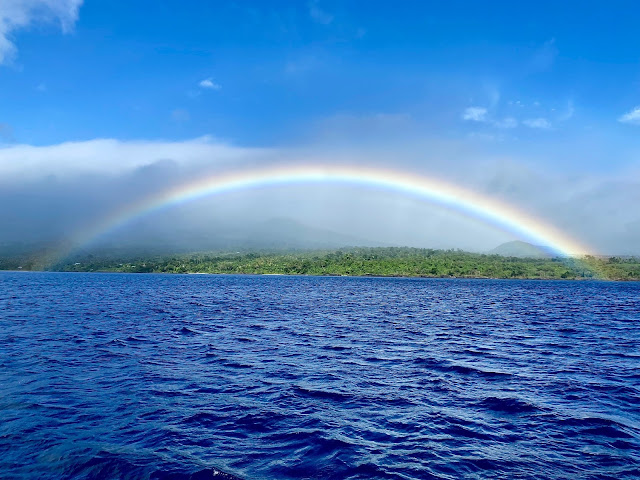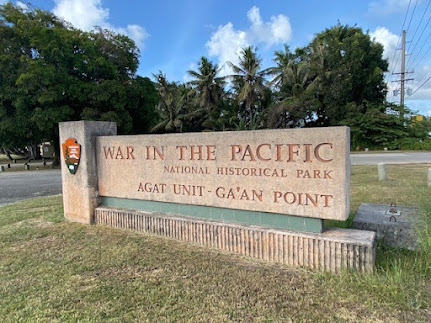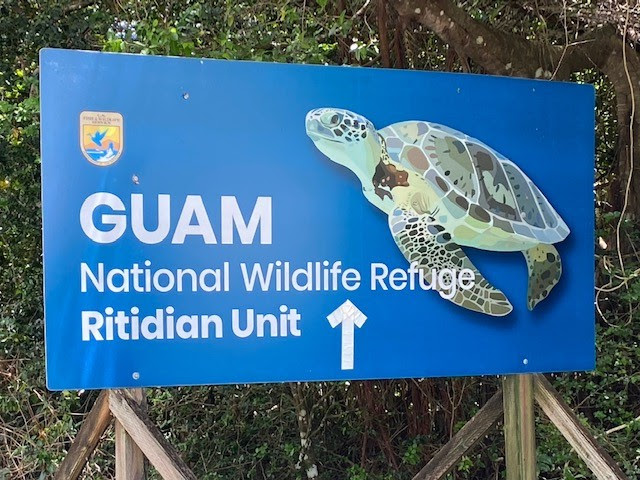 |
| Rainbow over Guam |
The work on the boat took up more time than expected. Also, unusually strong trade winds made putting up the Buddipole antenna rather precarious and presented an almost constant risk of breaking or bending something. And to be completely honest, I did in fact break one extension arm and bend one of the extension shock-cord whips while setting up and a gust came from the opposite direction from the prevailing winds! Finally, although we are not yet in the rainy season, there were numerous rain showers that soaked various the island periodically throughout the day. The short story is that I didn't get on the air and play radio as much as I wanted, but I'm not finished yet and there will be more to come!
War In The Pacific National Historical Park
(POTA K-0762)
Asan Beach Park
The War in the Pacific National Historical Park is actually 6 separate parks on the island of Guam. The largest of the 2 parks is Asan Beach in the village of Asan. This was the site of one of 2 main landing sites when the US Marines stormed Guam in 1944 to defeat the Japanese. However, very little remains of the fortifications and the area has been transformed into a popular beach park on the island.
 |
| 6 Units of War In the Pacific National Park in Guam |
 |
| Working POTA/DX in Guam |
On March 7, 2022, I activated the War in the Pacific National Historical Park (POTA K-0762). There are few picnic tables and no pavilions that would provide shade or protection from the weather. After spending a day to reconnoiter the vast park I finally decided on an area next to the parking lot at Asan Point to setup next to some bushes that would provide necessary shade. But the shade didn't appear until around 3 pm local time, and the park closed the gates at 6 pm. So, that gave me a 3-hour window to operate.
 |
| Asan Beach ops |
The first activation of this park was highly successful with 87 FT8 QSOs on 20M in about 3 hours of operation. Most of the QSOs were Japanese stations, but also include Indonesia, China, Brazil, Austria, Italy, Hawaii, Republic of Korea, North Macedonia, Texas, France, Spain, England, European Russia, Asiatic Russia, Australia, Denmark, and Canary Islands. I would say the propagation was great!
Based on my results from March 7, I returned to the same exact location in the park and setup on March 8. On day 2 of POTA operations at K-0110 I only made 74 FT8 QSOs on 20M. Hunters and DX'ers were from Republic of Korea, Japan, Texas, Hawaii, Uruguay, New Zealand, France, Asiatic Russia, China, England, Argentina, and Taiwan. Unfortunately, I had to stop transmitting and take 3 short breaks because the amplifier overheated. The average temperature in Guam is about 86F (30C) degrees. I only operated at about 50 watts and thought the almost constant winds would keep the amplifier cool. But for some reason on this day, I encountered an overheating problem.
Ga'an Point Park
 |
| 20cm Cannon |
 |
| Ga'an Point Ops |
All in all, with a little over 280 QSOs logged, March was not such a bad month.
Guam National Wildlife Refuge
(POTA K-0110)
 |
| Star Sand Beach |
 |
| Map of wildlife refuge on Guam |
 |
| Moved ops for passing squall. |
 |
| AH2/WA7WJR POTA 405 QSOs |
LESSONS LEARNED
- When setting up a tripod hang a bag of sand or rocks from the bottom of the mast. This is an old photographer's trick to steady camera tripods. The additional weight is useful during assembly, while raising and lowering, and adds overall stability to the antenna rig.
- Attach the guy lines to the mast, raise the mast, and secure the guy lines prior to attaching the antenna elements. This will prevent the mast from falling over with the antenna elements attached before the guy lines are secured. (Don't ask how I know this.)
- If the park is a wildlife refuge, make sure you contact the park superintendent and inquire about special use permits well in advance of your planned operations. Also, check with staff as to operating locations within the refuge.
- Find a shady spot to operate preferably with a good breeze. Don't forget water, sunscreen, and a good hat!
- Carry spare Buddipole extension arms and whips, or an alternate antenna (e.g., wire antenna).
- Pavilions are not always available. I'm going to look for a small 2-person tent to setup on days that have some probability of rain.
- When you go to a park to activate it for Parks on the Air talk to staff/rangers first to let them know what you're doing. Spend some time to identify operating locations that don't disturb the environment or other park visitors. And most importantly...spend some time enjoying the park and its beauty! Walk the trails, take a tour if available, and learn about the park's significance.






